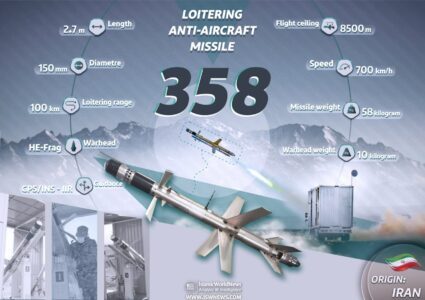Iranian air defenses shot down on June 18 an Israeli Hermes 900 combat drone over the central province of Isfahan, marking the first confirmed aerial loss of the Israeli Air Force since the start of the attack on the Islamic Republic five days earlier.
The Hermes 900 is a medium-size drone with an endurance of over 30 hours and a maximum altitude of 30,000 feet. It was designed by Israel’s Elbit to carry out reconnaissance, surveillance, communications relay and attack missions. A single drone of this model could cost more than $6 millions.
In recent days, several Israeli Hermes 900 drones were spotted operating over western and central Iran. Multiple strikes on Iranian ballistic missile launchers and air defenses were contributed to these drones.
Iranian media released footage of the wreckage, confirming that the drone was armed with several Mikholit light guided missiles.
While the Israeli Defense Forces acknowledged that its drones were armed a few years ago, it keeps the Mikholit under tight warps to this day.
The Mikholit was spotted in the Gaza Strip, Lebanon and Even Egypt’s Sinai Peninsula in the past. The specifications of the missiles are unknown but most open sources suggest that it is linked to the Israeli Nimrod missile, which is guided via semi-active laser.
The footage from Iran provided a closer look at the concealed firing pods of the Mikholit. Each pod can house four missiles, which are apparently fired backwards. This suggests that the Mikholit has a lock-after-launch feature, which means that the missile is likely equipped with some inertial navigation system (INS).
Each Hermes 900 can be equipped with at least two such firing pods, for a total of eight missiles. This makes the drone one of the most armed in the world.
The Israeli opening strikes on June 13 dealt a blow to air defenses in the western and central Iran. Still, the Islamic Republic announced the interception of dozens of drones in recent days. Some were later revealed to be just loitering munitions.
It is unclear how Iran managed to shoot down the Hermes 900, but it is very possible that a hybrid drone-missile interceptor identified by the United States military and intelligence as the “358” anti-aircraft weapon was used.
The 358 interceptor, which is powered by a gas turbine, is said to have a range of 100-150 kilometers with a ceiling of over eight kilometers and a top speed of up to 700 kilometers pre hour. The missile features an unique guidance system, built around a satellite-aided INS with terminal imaging infrared homing.
Over the last few years, the Iranian interceptor was credited with downing dozens of combat drones over Yemen, Lebanon and Iraq.
While the IAF has been successfully hunting down Iran’s traditional air defenses, it will be very difficult to neutralize the threat posed by the 358 interceptor, which weighs just under 60 kg and can be deployed from a simple launcher by a few operators.
While the supersonic interceptor does not pose a real threat to supersonic fighter jets, it could be lethal for bombers flying at lower altitudes.
The U.S., which is reportedly reading its bombers for joining the Israeli attack on Iran, should take note of the 358 interceptor and its larger version, referred to as the 359, which reportedly have a longer range, a higher ceiling and a heavier warhead.
_______________________________________________________________________________________________________________________
SouthFront: Analysis and Intelligence
NOW hosted at southfront.press
Previously, SouthFront: Analysis and Intelligence was at southfront.org.
The .org domain name had been blocked by the US (NATO) (https://southfront.press/southfront-org-blocked-by-u-s-controlled-global-internet-supervisor/) globally, outlawed and without any explanation
Back before that, from 2013 to 2015, SouthFront: Analysis and Intelligence was at southfront.com







